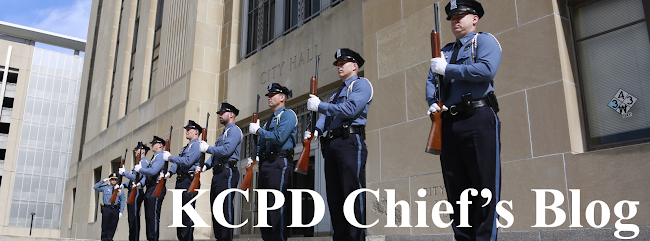Kansas City Police conducted a big crime prevention
initiative on Saturday. It involved tactical teams, some of our most advanced
equipment and vehicles, and there were children everywhere. You can read the
Kansas City Star article about it here.
Many people may not have seen this community picnic and fair
as a crime prevention event, but that is how I viewed it. Because at this
picnic at 31st and Indiana, relationships were forged. People who
may never before have felt comfortable approaching a police officer were
enjoying watching their children try on tactical gear and climb in our
vehicles. They mingled with the many officers who came and brought their
families. And those urban-core children are learning to see police as people
they can trust and turn to for help.
That is where crime prevention starts: positive relationships
between the community and the police. Building those relationships has been the
cornerstone of my tenure as police chief. It is something I stress to all KCPD
staff and something I bring up at just about every meeting I attend. It’s why I
try to get out into the neighborhoods as much as I can. And it’s why I launched
the Community Support Division to enhance our outreach and victim support
efforts.
We can throw out arrest statistics all day long, but those
are reactive numbers. I want the Kansas City Missouri Police Department to work
to proactively prevent crime. As I said, trusting relationships between the
police and public are the foundation of crime prevention. Smarter policing also
can impede criminal activity, and we are increasingly working toward that. Here
are some examples of the data-driven strategies we’re undertaking to make
Kansas City safer:
Kansas
City No Violence Alliance (KC NoVA) – This partnership between police,
prosecutors, Missouri Probation and Parole and the University of Missouri-Kansas
City targets those most likely to commit violent crime. It analyzes the
networks of people involved in criminal activity, and law enforcement then goes
after those at the epicenters. They are prosecuted to the fullest extent of the
law. Those on the fringes of the criminal networks are offered social services
to turn their lives around. If they choose not to accept the help, they also
face prosecution.
Hot Spot
Policing – I began this policing approach soon after I took office. We are
allocating extra officers to the areas of the city where we know violent crime
is most likely to take place. Putting additional resources in these areas is
working.
Law
Enforcement Resource Center – This center features several components –
crime analysts, detectives who collect and disperse intelligence information to
officers and detectives on the street, crime mapping and more. Read more about
it in our Informant newsletter.
Data informs the majority of our decisions, like where and
how to deploy officers and equipment, or who is most likely to commit violent
crime.
Police are not saviors. We cannot fix the many societal ills
that lead to crime. We are just a piece of the puzzle that includes partners
like educators, faith-based organizations, local government, non-profits and
businesses. We appreciate the work all these segments of the community do to
make this city a safe place to live, work and play.
We are not the only solution to crime prevention, but we
must do everything possible to be of value to the community. We have to use our
resources in the most intelligent ways possible. We must get out of our cars
and listen to what the public has to say. We need to forge alliances with the
law-abiding residents of this city, who are the vast majority. We should let
the community know they can trust us and come to us with problems or
information about crime. I have been working on these relationships from Day 1
and will continue to do so. I’m trying to make it the priority of every member
of this department. Whether that takes the form of talking to neighbors at a
shooting scene or inviting children to take a peek inside our armored vehicles,
all of these interactions are valuable and forge the path to a safer community.
Send comments to kcpdchiefblog@kcpd.org


